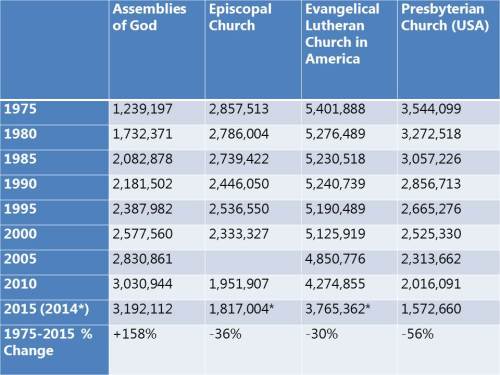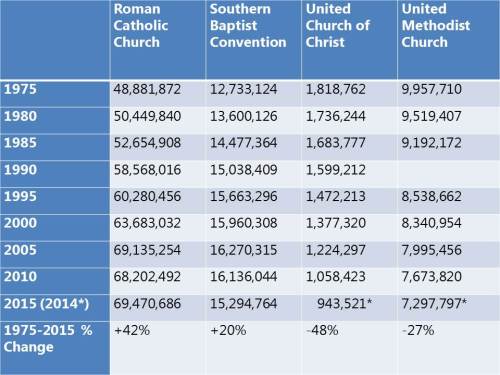June 24, 2016. 10:14 pm.
The Assemblies of God is one of the few major denominations in the United States to show continuing growth. But the real story is the ethnic transformation of the Assemblies of God. It is becoming less white and more reflective of the ethnic, linguistic and social diversity that exists in the global church.
When the Assemblies of God (AG) released its 2015 statistical reports this month, the press release noted that the denomination’s number of U.S. adherents had grown for 26 consecutive years. In 2015, the AG showed growth of 1.4% to 3,192,112 U.S. adherents. This was almost double the growth rate of the U.S. population, which increased by 0.77%.
The number of U.S. churches also showed growth (from 12,849 to 12,897, up 0.4%), as did the numbers of members (up 0.3%), ministers (up 0.5%), and major worship service attendance (up 1.7%). Statistics for other key indicators of church health–including conversions and Spirit baptisms and water baptisms–have not yet been released.
Much of the numerical growth in the Assemblies of God in recent decades has been among ethnic minorities. From 2001 to 2015, the number of AG adherents increased by 21.5%. During this period, the number of white adherents decreased by 1.6% and the number of non-white adherents increased by 76.8%. From 2014 to 2015, the percentage of white adherents dropped from 57.6% to 57.2%. It should be noted that the number of white adherents in the U.S. includes quickly-growing constituencies of immigrants from places such as the former Soviet Union and Romania. Without these new white immigrants, the white constituency in the Assemblies of God would be falling even more quickly.
The growth of the Assemblies of God is in marked contrast to most mainline Protestant denominations in the U.S., which have witnessed significant numerical declines in recent decades. From 1975 to 2015, the Presbyterian Church (USA) lost 56% of members; United Church of Christ lost 48%; The Episcopal Church lost 36%; the Evangelical Lutheran Church in America lost 30%; and the United Methodist Church lost 27%. Others showed increases, including the Southern Baptist Convention (20%) and the Roman Catholic Church (42%). During the same period, the Assemblies of God grew by 158%, from 1,239,197 adherents in 1975.
While mainline denominations have been declining for decades, in recent years some evangelical groups, such as the Southern Baptist Convention (SBC), have also begun to decline. SBC membership has decreased for nine straight years, prompting some pundits to predict the slow death of evangelicalism. Others have pointed out that Pentecostal and non-denominational churches show continuing growth. Faith trends expert Ed Stetzer has argued that American Christianity is undergoing “evangelicalization,” noting that the percentage of Americans who identify as evangelical or born-again is increasing. And much of that growth can be attributed to soaring numbers of ethnic minorities in churches.
In 2015, over 42% of U.S. Assemblies of God adherents were non-white. This is comparable to the ethnic diversity in the U.S. Catholic Church. According to arecent Pew study, 41% of U.S. Catholics are now racial and ethnic minorities (up from 35% in 2007). The study also revealed that 24% of evangelical Protestants (up from 19%) and 14% of mainline Protestants (up from 9%) are also racial and ethnic minorities.
The ethnic breakdown of the AG in 2015 showed significant diversity: Asian/Pacific Islander (4.8%); Black (9.7%); Hispanic (23.0%); Native American (1.5%); White (57.2%); and Other/Mixed (3.9%). These stats suggest that the AG closely mirrors the ethnic makeup of the U.S. population as a whole. The 2010 U.S. census revealed the following racial breakdown of the U.S. population: Asian/Pacific Islander (5%); Black (12.6%); Hispanic (16.3%); Native American (0.9%); White (63.7%); and Other /Mixed (6.2%).
The AG districts with the greatest percentage growth in the number of adherents from 2010 to 2015 are as follows: National Slavic (152%), Midwest Latin American (58%), North Dakota (56%), Minnesota (55%), German (51%), Korean (33%), Texas Louisiana Hispanic (29%), Hawaii (29%), South Texas (26%), and Brazilian (24%). Due to the changing borders of the Hispanic districts, which doubled from seven to fourteen in the past six years, data for most of these districts was unavailable for purposes of comparison.
The AG’s growth in America is partly due to immigration. The Assemblies of God is a global church. The Assemblies of God reported 67,992,330 adherents worldwide in 2015. About 1% of the world’s population is AG. Fewer than 5% of AG adherents worldwide live in the U.S. Pentecostals who move to America from other regions of the world often bring with them a faith, burnished by persecution and deprivation, that is an important part of their identity. Pentecostal refugees who move to America are like pollen scattered by a strong wind — they plant churches wherever they happen to land. Strong African, Slavic, Asian, Pacific Islander, and Hispanic AG churches are taking root in American soil, and their congregations sing, preach, and testify in the tongues of their native countries.
Interestingly, this demographic shift is also helping to usher in a global re-alignment of Christianity. Anglican, Presbyterian, and Methodist Christians in Africa, Asia, and Latin America are generally evangelical in belief, if not Pentecostal in worship, and often have much more in common with their brothers and sisters in the Assemblies of God than they do with liberal members of their own denominations in the West.
The Assemblies of God is growing in America, due largely to a transformative demographic shift that has been underway for decades. The founding fathers and mothers of the Assemblies of God laid the foundation for this ethnic shift when they committed the Assemblies of God in November 1914 to “the greatest evangelism that the world has ever seen.” In 1921 the Assemblies of God adopted the indigenous church principle as its official missions strategy, in order to better carry out world evangelism. The implementation of this strategy — which recognizes that each national church is autonomous and not controlled by Western interests — resulted in the development of strong national churches and leaders. And now, in a fitting turn of events, those churches are sending missionaries to America.
Photo: Scott Temple (Director of Ethnic Relations for the Assemblies of God) and Bill Welch (Alaska District Superintendent) pray over elected officials of the newly-formed Samoan District Council, in a meeting at Anchorage, Alaska, September 2013. By 2015, the Samoan District Council, which serves Samoans in the United States, had grown to 54 churches with 5,444 adherents.


Sources for charts:
Assemblies of God
Episcopal Church
Evangelical Lutheran Church in America
Presbyterian Church (USA)
Roman Catholic Church
Southern Baptist Convention
United Church of Christ
United Methodist Church
Assemblies of God
Episcopal Church
Evangelical Lutheran Church in America
Presbyterian Church (USA)
Roman Catholic Church
Southern Baptist Convention
United Church of Christ
United Methodist Church
Notes:
ELCA: Formed in 1987 by a merger of three bodies: American Lutheran Church (1960-1987); Lutheran Church in America (LCA) (1962-1987); and Association of Evangelical Lutheran Churches (AELC) (1976-1987). Tallies for 1975, 1980, and 1985 include stats of predecessor bodies. The AELC was a split from the Lutheran Church-Missouri Synod (LCMS) in 1976. The 1975 tally does not include stats for LCMS churches which later formed the AELC, which has the effect of understating the ELCA’s loss from 1975 to the present.
PC(USA): Formed in 1983 by a merger of United Presbyterian Church in the U.S.A. and the Presbyterian Church in the United States. Tallies for 1975 and 1980 include stats of predecessor bodies.
ELCA: Formed in 1987 by a merger of three bodies: American Lutheran Church (1960-1987); Lutheran Church in America (LCA) (1962-1987); and Association of Evangelical Lutheran Churches (AELC) (1976-1987). Tallies for 1975, 1980, and 1985 include stats of predecessor bodies. The AELC was a split from the Lutheran Church-Missouri Synod (LCMS) in 1976. The 1975 tally does not include stats for LCMS churches which later formed the AELC, which has the effect of understating the ELCA’s loss from 1975 to the present.
PC(USA): Formed in 1983 by a merger of United Presbyterian Church in the U.S.A. and the Presbyterian Church in the United States. Tallies for 1975 and 1980 include stats of predecessor bodies.
_________________
Do you have Pentecostal historical materials that should be preserved? Please consider depositing these materials at the Flower Pentecostal Heritage Center (FPHC). The FPHC, located in the Assemblies of God national offices, is the largest Pentecostal archive in the world. We would like to preserve and make your treasures accessible to those who write the history books.
Flower Pentecostal Heritage Center
1445 North Boonville Avenue
Springfield, Missouri 65802 USA
Phone: 417.862.1447 ext. 4400
Toll Free: 877.840.5200
Email: archives@ag.org
Website: www.iFPHC.org
1445 North Boonville Avenue
Springfield, Missouri 65802 USA
Phone: 417.862.1447 ext. 4400
Toll Free: 877.840.5200
Email: archives@ag.org
Website: www.iFPHC.org
Source: https://ifphc.wordpress.com/2016/06/24/assemblies-of-god-2015-statistics-released-growth-spurred-by-ethnic-transformation/